Tuesday, April 29, 2014
Friday, April 25, 2014
Bigfoot Math: Measuring foot length and stride patterns
As part of our investigation of Big Foot lore, we're evaluating the methodology of the evidence gathered.
In Math, we spent some time creating and measuring a range of human stride patterns:
We'll be following up today by analyzing the range of data that we collected.
Wednesday, April 23, 2014
STEM: Desktop natural selection
 |
| A predator prepares to feed. |
1. The predator
2. The data recorder
3. The Benevolent Hand of Nature
We started with a population of colored dots, which all represent specimens of some species of organism. They are the prey for our predators. The phenotype of these organisms causes them to appear as either red, blue, yellow, or white. To begin with, these organisms were living in an environment (represented by a large sheet of paper) that was yellow.
First, the Benevolent Hand of Nature placed a specific number of dots into the environment. Then, the data recorder took stock of the numbers. When signaled, the person in the role of the predator was to look at the paper and then immediately grab ("eat") the first dot that they saw. Then they'd look away until they were signaled to pick another one.
This simulated a situation in which a predator was hunting, spotting, and eating prey. After each "feeding," the surviving dots would reproduce a new generation of offspring. Blue dots spawned more blue dots, yellow dots spawned more yellow dots, and so on. Then we began a new round of feedings. The data recorder kept track of the changing population numbers, while the Benevolent Hand of Nature made sure to make sure that the dots were stocked in the environment appropriately.
After several rounds, trends emerged. The yellow dots seemed to be quite prolific in this environment, and they went on to have many offspring after each round. The blue and red dots were less successful.
Then, their fortunes changed.
We simulated a change in the environment by switching from a yellow background to a red one. This could have represented any number of changes in nature; cloudy water, deforestation, industrial pollution, etc. With this change, suddenly the yellow dots became much more visible to our hungry predators. We saw their population growth level off accordingly.
We also revisited the idea of recessive traits, first discussed a few months ago during our Identity theme. Red dots, which had largely disappeared from the environments of most groups, spontaneously reappeared when we declared that a certain number of the white dots had been carrying a recessive gene for red. Though there were only a few that were reintroduced, the fact that they were now living in an environment that effectively camouflaged their presence buoyed our optimism about their chances to rebound.
After a class discussion spent sharing observations and theories about what we had seen, we concluded with the famous story of the Peppered Moth. It's a great example to help conceptualize natural selection, both as an idea, and the occasional controversies that surround it. Ask your student to tell you about the story of the changing appearance of the Peppered Moths!
Having laid this groundwork, we'll be wrapping it into our study of Big Foot. What traits might he/she/it possess that would make it successful (or unsuccessful) in the environments in which it is supposed to exist? What about other cryptids and mythological beasts?
Cryptozoology: pondering Big Foot
Our current theme is Mythology, and we've spent much of this week studying the (pseudo)science of cryptozoology, focused largely on the myth of Big Foot.
We kicked off the week by viewing some infamous footage:
We've read a few different historic accounts of Big Foot (also known by several other names), including The Story of Jacko, 1884. Students spent some time breaking down what each article actually says, writing answers to the following questions:
1. Who reported the incident? (And to whom?)
2. What was observed? (Give a precise description, including quotations from witnesses.)
3. What was the time and date of the incident?
4. Where is the exact location that this incident occurred?
5. What information do we have about the witnesses? (What were their jobs, ages, etc?)
We applied these questions to a few written accounts. Under close scrutiny, we found that many of these questions were impossible to answer, even though they were reports published in presumably reputable periodicals.
Big Foot has also crept into other areas of our studies, inspiring this fascinating range of portraits from Art class:
We kicked off the week by viewing some infamous footage:
We've read a few different historic accounts of Big Foot (also known by several other names), including The Story of Jacko, 1884. Students spent some time breaking down what each article actually says, writing answers to the following questions:
1. Who reported the incident? (And to whom?)
2. What was observed? (Give a precise description, including quotations from witnesses.)
3. What was the time and date of the incident?
4. Where is the exact location that this incident occurred?
5. What information do we have about the witnesses? (What were their jobs, ages, etc?)
We applied these questions to a few written accounts. Under close scrutiny, we found that many of these questions were impossible to answer, even though they were reports published in presumably reputable periodicals.
Big Foot has also crept into other areas of our studies, inspiring this fascinating range of portraits from Art class:
Later in the week, we'll be investigating other pieces of evidence that are often cited when discussing Big Foot, including studying the foot size and stride length of humans.
Ford River Rouge Plant tour
We visited the Henry Ford River Rouge Plant last Friday, the highlight of which was touring the factory where the Ford F-150 is assembled.
Photography was strictly forbidden, which is a shame. I would have loved to have taken a few pictures of the awestruck faces watching as partially-assembled trucks sailed above, below, and around us in a carefully choreographed ballet. It was hypnotic.
Someone else in the world broke the no-photography rule, so here's a glimpse of what we saw:
We also visited the observation deck, where you can see the rest of the plant sprawling out before you, crowned with one of the world's largest living roofs.
| (We weren't quite this high up.) |
Back at school, we showed a couple of classic clips that were relevant to what we had seen:
I Love Lucy:
Charlie Chaplin in Modern Times:
You may or may not be surprised to hear that the comedy holds up!
Wednesday, April 16, 2014
ART: Guest artist Jennifer Hoffman
Place Out of Time: The importance of reflections
Our Place Out of Time experience is nearing its conclusion, and the middle school gathered this morning to begin talking about the value of reflection. We opened with a few quotes. The first two come from John Dewey.
- “We do not learn so much from experience as we do from reflecting on our experience.”
- “Perhaps the greatest of all pedagogical fallacies is the notion that a person learns only the particular thing he is studying at the time.”
- – John Dewey
(New vocabulary words for most of the group: "pedagogical" and "fallacies.")
The third came from a source a little more familiar to many of us:
- Harry stared at the stone basin. The contents had returned to their original, silvery white state, swirling and rippling beneath his gaze.
- “ What is it?” Harry asked shakily.
- “This? It is called a Pensieve,” said Dumbledore. “ I sometimes find, and I am sure you
- know the feeling, that I simply have too many thoughts and memories crammed into my
- mind.”
- “Err,” said Harry who couldn’t truthfully say that he had ever felt anything of the sort.
- “At these times” said Dumbledore, indicating the stone basin, “ I use the Penseive. One simply siphons the excess thoughts from one’s mind, pours them into a basin, and examines them at one’s leisure. It becomes easier to spot patterns and links, you
- understand, when they are in this form.’
- - Excerpt from Harry Potter and the Goblet of Fire, by J. K. Rowling
This lead to a good discussion about the value of externalizing an experience in order to really process it. By getting it out of your head and onto paper (or onto a screen), you can look at things from a new perspective.
It is perhaps worth noting that I looked like this for the duration of this discussion:
 |
| (If you look closely, you might notice a hint of dry erase marker on my face.) |
I used myself as an example. As a teacher, you have to earn the respect of your students. Were I to get dressed each day, look myself up and down, and leave the house without looking in the mirror, my day might look a lot like this:
 |
| For some reason, I am failing to command their respect. |
A mirror provides an external reflection that gives one instantaneous feedback on aspects of your appearance that you would otherwise be unable to see.
Dumbledore's Penseive serves a similar function. By getting his thoughts out of his head, he's able to parse through them from a different perspective.
There are any number of ways to reflect on something, but we started with a simple format:
1. What?
- What are you reflecting on? Be objective. Don't add commentary or emotion, simply describe what Place Out of Time is, as you might explain it to a new student or a parent.
2. So what??
- Now that you've objectively articulated the basics of the project, begin writing about your own experiences. What was the value of the experience? What did you learn? What skills did you develop? What was particularly challenging? Where did you exceed your expectations? Where did you fall short? What did you like and dislike about the experience?
3. Now what???
- After thinking and writing about your experience and performance, how can you learn from it? What were the causes of your struggles, and how can you address them? Where did you thrive, and what does that say about your interests and skills?
After our discussion, we began writing our reflections (and I washed my face). We'll continue working on them the rest of the week.
Tuesday, April 15, 2014
Place Out of Time banquet!
We kicked off the week by attending the annual Place Out of Time banquet on Monday! We'll be posting a more detailed write up soon. In the meantime, take a look at this amazing gathering of luminaries from throughout time:
 |
| Our own Lady Gaga addresses the assembly. |
 |
| Charles Taylor, Calvin Johnson, Michael Jackson, Harry Houdini, and Pope Francis engage in a spirited debate. |
Thursday, April 3, 2014
The Jackson 5 (+1)!
Tuesday, April 1, 2014
Math on 4/1/2014
Sam gave a difficult assignment in Math morning. In fact, most felt that it was absolutely impossible. In fact, it was! Happy April Fools' Day!
After some time spent attempting to work on the problems alone, students quickly figured out that they weren't able to be solved as written. They were then given a new assignment: identify why each problem is impossible, then rewrite each to include the information required to solve it.
After some time spent attempting to work on the problems alone, students quickly figured out that they weren't able to be solved as written. They were then given a new assignment: identify why each problem is impossible, then rewrite each to include the information required to solve it.
Subscribe to:
Comments (Atom)



























